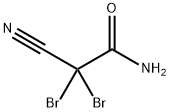DIBROMOACETONITRILE
- CAS NO.:3252-43-5
- Empirical Formula: C2HBr2N
- Molecular Weight: 198.84
- MDL number: MFCD00001856
- EINECS: 221-843-2
- SAFETY DATA SHEET (SDS)
- Update Date: 2024-12-18 14:15:30

What is DIBROMOACETONITRILE?
Chemical properties
Clear colorless to yellow liquid
The Uses of DIBROMOACETONITRILE
Dibromoacetonitrile is a carcinogenic nitrogenous disinfection byproduct. Dibromoacetonitrile in drinking water was linked to oral cavity cancer in rats and forestomach cancer in mice. In addition, Dibromoacetonitrile may cause oxidative damage in rat brain.
Definition
ChEBI: Dibromoacetonitrile is an aliphatic nitrile.
General Description
Clear amber oily liquid.
Air & Water Reactions
DIBROMOACETONITRILE may be sensitive to prolonged exposure to air and light. Slightly soluble in water.
Reactivity Profile
DIBROMOACETONITRILE is incompatible with strong acids, strong bases, strong oxidizing agents and strong reducing agents. . Nitriles may polymerize in the presence of metals and some metal compounds. They are incompatible with acids; mixing nitriles with strong oxidizing acids can lead to extremely violent reactions. Nitriles are generally incompatible with other oxidizing agents such as peroxides and epoxides. The combination of bases and nitriles can produce hydrogen cyanide. Nitriles are hydrolyzed in both aqueous acid and base to give carboxylic acids (or salts of carboxylic acids). These reactions generate heat. Peroxides convert nitriles to amides. Nitriles can react vigorously with reducing agents. Acetonitrile and propionitrile are soluble in water, but nitriles higher than propionitrile have low aqueous solubility. They are also insoluble in aqueous acids.
Fire Hazard
Literature sources indicate that DIBROMOACETONITRILE is nonflammable.
Safety Profile
Poison by intravenous route. Questionable carcinogen with experimental carcinogenic data. Experimental reproductive effects. Human mutation data reported. See also NITRILES and BROMIDES. When heated to decomposition it emits very toxic fumes of NO,, Br-, and CN-
Properties of DIBROMOACETONITRILE
| Boiling point: | 67-69 °C (24 mmHg) |
| Density | 2.29 |
| refractive index | 1.538-1.543 |
| Flash point: | 37°C |
| storage temp. | 0-6°C
|
| solubility | Chloroform (Soluble), Methanol (Sparingly) |
| form | neat |
| Sensitive | Light Sensitive |
| BRN | 1739037 |
| Stability: | Light Sensitive |
| CAS DataBase Reference | 3252-43-5(CAS DataBase Reference) |
| IARC | 2B (Vol. 52, 71, 101) 2013 |
| EPA Substance Registry System | Dibromoacetonitrile (3252-43-5) |
Safety information for DIBROMOACETONITRILE
| Signal word | Danger |
| Pictogram(s) |
 Skull and Crossbones Acute Toxicity GHS06  Health Hazard GHS08  Environment GHS09 |
| GHS Hazard Statements |
H301:Acute toxicity,oral H319:Serious eye damage/eye irritation H351:Carcinogenicity H410:Hazardous to the aquatic environment, long-term hazard |
| Precautionary Statement Codes |
P201:Obtain special instructions before use. P273:Avoid release to the environment. P305+P351+P338:IF IN EYES: Rinse cautiously with water for several minutes. Remove contact lenses, if present and easy to do. Continuerinsing. |
Computed Descriptors for DIBROMOACETONITRILE
New Products
(S)-3-Aminobutanenitrile hydrochloride 4-Methylphenylacetic acid N-Boc-D-alaninol N-BOC-D/L-ALANINOL Tert-butyl bis(2-chloroethyl)carbamate 3-Morpholino-1-(4-nitrophenyl)-5,6-dihydropyridin- 2(1H)-one Furan-2,5-Dicarboxylic Acid Tropic acid 1-Bromo-3,5-Di-Tert-Butylbenzene S-2-CHLORO PROPIONIC ACID ETHYL ISOCYANOACETATE 2-Bromo-1,3-Bis(Dimethylamino)Trimethinium Hexafluorophosphate 4-IODO BENZOIC ACID 3-NITRO-2-METHYL ANILINE 1-(2,4-DICHLOROPHENYL) ETHANAMINE (2-Hydroxyphenyl)acetonitrile 4-Bromopyrazole 2-(Cyanocyclohexyl)acetic acid 4-methoxy-3,5-dinitropyridine 1-(4-(aminomethyl)benzyl)urea hydrochloride 2-aminopropyl benzoate hydrochloride diethyl 2-(2-((tertbutoxycarbonyl)amino) ethyl)malonate tert-butyl 4- (ureidomethyl)benzylcarbamate Ethyl-2-chloro((4-methoxyphenyl)hydrazono)acetateRelated products of tetrahydrofuran








You may like
-
 Dibromoacetonitrile CAS 3252-43-5View Details
Dibromoacetonitrile CAS 3252-43-5View Details
3252-43-5 -
 Dibromoacetonitrile CAS 3252-43-5View Details
Dibromoacetonitrile CAS 3252-43-5View Details
3252-43-5 -
 1975-50-4 98%View Details
1975-50-4 98%View Details
1975-50-4 -
 2-HYDROXY BENZYL ALCOHOL 98%View Details
2-HYDROXY BENZYL ALCOHOL 98%View Details
90-01-7 -
 2-Chloro-1,3-Bis(Dimethylamino)Trimethinium Hexafluorophosphate 221615-75-4 98%View Details
2-Chloro-1,3-Bis(Dimethylamino)Trimethinium Hexafluorophosphate 221615-75-4 98%View Details
221615-75-4 -
 61397-56-6 CIS BROMO BENZOATE 98%View Details
61397-56-6 CIS BROMO BENZOATE 98%View Details
61397-56-6 -
 14714-50-2 (2-Hydroxyphenyl)acetonitrile 98+View Details
14714-50-2 (2-Hydroxyphenyl)acetonitrile 98+View Details
14714-50-2 -
 118753-70-1 98+View Details
118753-70-1 98+View Details
118753-70-1